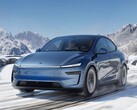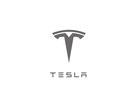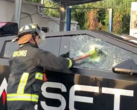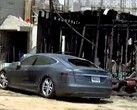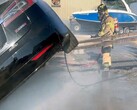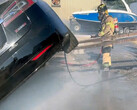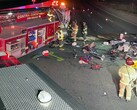Tesla says it can take up to 8,000 gallons of water to extinguish a burning battery in one of its vehicles, while fire hazard from electric vehicles is a common warning on ferries, some of which refuse taking them on board.
Just recently, a second car carrier ship sank before the deck with electric cars that caught fire could be extinguished, too. In its newest environmental impact report, however, Tesla tries to dispel the myth that electric cars catch fire all the time.
Electric vs ICE cars fire incidents
Using a somewhat debatable metric of vehicle fires per billion miles driven, it says that its EVs catch fire eight times less often than the national average in the US. For every one billion miles on the road, there have been 6.5 incidents of Teslas burning for various reasons, while the US average is 55 across all vehicle categories and powertrains. Needless to say, the average Tesla is also a much newer car than the US vehicle fleet that is now fast approaching the 13-year-old mark, a new record.
The problem with Tesla vehicle fires is not that much that they are a more common occurrence compared with gas-powered cars, but that they are very hard to put out even with extinguishers certified for electric fires like First Alert's rechargeable unit. Electric car batteries in thermal runaway mode can spontaneously ignite over and over, so firefighters have to undergo special training and sometimes use dedicated tools that pierce the battery housing and douse the cells inside directly.
Just one burning Tesla Semi, for instance, took an amount of water that usually goes to extinguish 50 ICE vehicles before the fire was put out, and the incident even involved a firefighting plane as the Semi crashed in a forest.
Tesla safety record vs human drivers
Besides fires or lifecycle emissions, the 2025 Tesla environmental impact report includes safety statistics, too. Tesla says that its cars are ten times safer than a human driver when the Autopilot driver-assist option is used.
Tesla vehicles with Autopilot technology engaged get involved in one incident per 6.77 million miles driven, while the US average is 0.7 million miles. Even without Autopilot, other active safety features in Tesla cars return a longer, 1.18 million miles travelled between accidents on average.
Tesla stays mum on the safety record of its Full Self-Driving (FSD) feature compared to human drivers, though. FSD is a paid option and is used a lot for city driving that is much more chaotic.
Tesla recently brought unsupervised FSD to public roads in Austin to debut its Robotaxi ride-share platform, and just started to amass the safety data on that undertaking. The city of Austin rates Tesla's unsupervised FSD at Level 4 on the vehicle autonomy scale, meaning that it doesn't need the input of a human driver, but the jury is still out on the safety record of the driverless Model Y units that Tesla started its Robotaxi service with.
Source(s)
Tesla (PDF)








